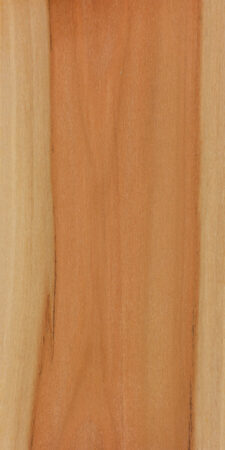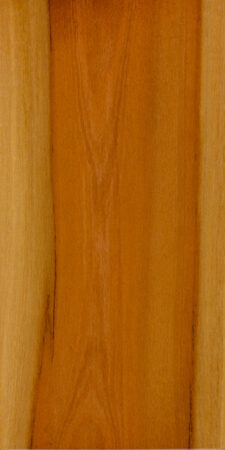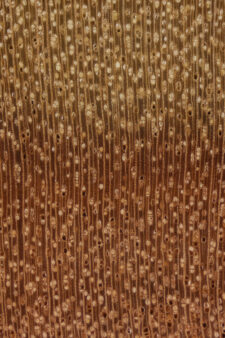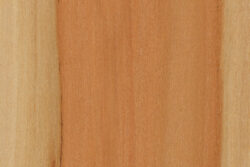Common Name(s): Red ash, soaptree, red almond
Scientific Name: Alphitonia excelsa
Distribution: Australia
Tree Size: 65-85 ft (20-25 m) tall,
2-3 ft (.6-1 m) trunk diameter
Average Dried Weight: 45.2 lbs/ft3 (725 kg/m3)
Specific Gravity (Basic, 12% MC): .62, .72
Janka Hardness: 1,890 lbf (8,400 N)
Modulus of Rupture: 19,430 lbf/in2 (134.0 MPa)
Elastic Modulus: 2,755,000 lbf/in2 (19.00 GPa)
Crushing Strength: 10,150 lbf/in2 (70.0 MPa)
Shrinkage: Radial: 3.5%, Tangential: 9.3%,
Volumetric: 13.0%, T/R Ratio: 2.7
Color/Appearance: Heartwood is orangish pink, while contrasting sapwood is pale yellow. Heartwood colors can be streaked and varied, and tend to darken with age.
Grain/Texture: Grain is straight, with a moderate to fine even texture.
Rot Resistance: Rated as moderately durable; susceptible to termites, but resistant to powder post beetles.
Workability: Easy to work with both hand and machine tools. Turns, glues, and finishes well.
Odor: Bark can have a strong mint-like scent, though the dried wood has little to no odor.
Allergies/Toxicity: Besides the standard health risks associated with any type of wood dust, no further health reactions have been associated with red ash. See the articles Wood Allergies and Toxicity and Wood Dust Safety for more information.
Pricing/Availability: Not a commercial species, though limited quantities may be available within its natural range for craft and hobbyist purposes. Expect prices to be moderate for a domestic hardwood.
Sustainability: This wood species is not listed in the CITES Appendices, and is reported by the IUCN as being a species of least concern.
Common Uses: Veneer, flooring, furniture, cabinetry, musical instruments, carving, and turned objects.
Comments: Despite its common name, red ash is not botanically related to true ashes in the Fraxinus genus. It’s actually more closely related to buckthorn (Rhamnus cathartica), and both are contained in the broader Rhamnaceae (buckthorn) family.
Although not a commercial timber, red ash tends to be the densest and strongest of the Alphitonia species that are used for lumber. Red ash has an excellent strength-to-weight ratio, particularly in the areas of MOE and MOR.
Images: Drag the slider up/down to toggle between raw and finished wood.
Identification: See the article on Hardwood Anatomy for definitions of endgrain features.
Porosity: diffuse porous
Arrangement: radial multiples of 2-5 pores
Vessels: medium to large, few; light brown or reddish colored deposits present
Parenchyma: vasicentric
Rays: medium; normal spacing
Lookalikes/Substitutes: The combination of the pinkish orange heartwood and large pores occurring primarily as radial multiples makes red ash a wood that’s hard to confuse with much else.
Notes: Red ash (Alphitonia excelsa) can usually be separated from the closely related pink ash (A. petriei) on the basis of weight—red ash tends to be considerably heavier (725 kg/m3 vs 515 kg/m3).
Related Content:











